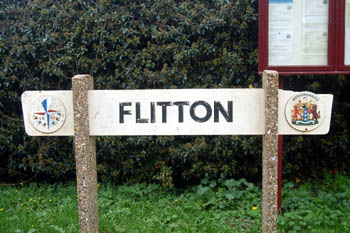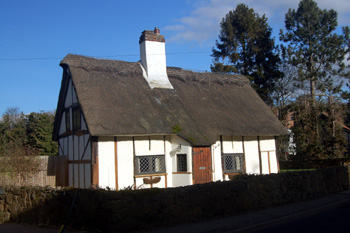The Parish of Flitton in General
Landscape

Flitton Hill looking towards Hollington October 2011
Volume II of The Victoria County History for Bedfordshire, published in 1908 states that Flitton then had an area of 1,061 acres of which 413 acres, 1 rood were arable and 460 acres, 3 roods grassland. Crops were wheat, barley, potatoes and beans. Since then the parish has grown due to boundary changes in 1933 and 1984 (see below).
The solid, or underlying geology is a sandstone known as Woburn Sands Formation. This was laid down between 99 and 121 million years ago in the Cretaceous Period in shallow seas. This means that the top soil is also sandy. Several sand pits in the parish attest to this. A small outcrop of lower greensand occurs in the north of the parish and, heavily treated, is used for market gardening.
The highest point in the parish is in the south, where the ground climbs towards Pulloxhill, and stands at about 300 feet above sea level. The lowest point, in the north at Hollington Bridge lies at 182 feet. Flitton church stands at 215 feet above sea level and the top of Flitton Hill is about 260 feet.

Flitton sign October 2010
Name
The name Flitton is bound up with the River Flit or Flitt. The name of the river comes from the Old English word "fleot" meaning a small stream. The place name thus means farm by the small stream or farm by the Flitt. The name has appeared in the following forms over the years with the modern form first being found in 1318:
- Flichtham: 1086;
- Flitte: 1166-1428;
- Flytte: 1166-1428;
- Flete: 1183;
- Fliuten: c. 1200-1225;
- Flitten: c. 1200-1327;
- Flette: 1240;
- Flyten: 1260;
- Flyte: 1262;
- Flit: 1286;
- Flute: 1291;
- Flytton: 1318-1526;
- Flyten: 1331.

The church from the south February 2011
Administrative History
Flitton is an ancient parish in the Flitt Hundred. It has always included the hamlet of Wardhedges. Flitton used to include the hamlet of Silsoe. Silsoe chapel was rebuilt by the 2nd Earl de Grey in 1830-1831 and became the church of a new ecclesiastical parish of Silsoe in 1846. In 1866 a new civil parish of Silsoe was also created.
Greenfield used to be in the strange position that it was a hamlet in both the ancient parishes of Flitton and of Pulloxhill. The boundary between the two parishes ran down the middle of the High Street and doen the middle of the western part of Flitton Road. Buildings north of this line were in Flitton, those to the south were in Pulloxhill. In addition the area around Greenfield Mill was a detached part of the parish of Pulloxhill. This was transferred to Flitton in 1933 [CDP55].
In 1954 a committee was set up to consider amalgamating Flitton and Pulloxhill but this came to nothing [PCFlitton20/1]. In 1961 boundary changes were again considered, but no action taken [PCFlitton20/2].
Finally, in 1984 the current boundary was established putting most of the houses in Greenfield into the new civil parish of Flitton and Greenfield [CDP82]. Oak Drive and Maple Close both adjoin Greenfield but still [2011] lie in the parish of Pulloxhill.
Flitton used to be bordered to the north-east by Clophill, now by Silsoe; to the east by Upper Gravenhurst and to the south-east by Lower Gravenhurst and by Higham Gobion, now these three places have been replaced as neighbours by Pulloxhill; to the south by Barton-le-Clay, again now replaced by Pulloxhill; to the south-west by Pulloxhill, now by Greenfield; to the west by a detached part of Higham Gobion separating it from Greenfield; now by Greenfield and by Flitwick, now just Flitwick; and to the north-west by Maulden as it still does.

41 High Street from the south-west February 2011
Population
The Domesday Book of 1086 records 10 people in Flitton. These are just the heads of households and so the figure must be multiplied by a factor of at least four, suggesting around 40 people, making it a small settlement for the time.
The population of Flitton and Greenfield today [2011] is roughly four times that of two hundred years ago. Much of this increase is explained by the growth of Greenfield in particular in the last ten or fifteen years. The following population figures are taken from censuses.
- 1801: 292;
- 1811: 382;
- 1821: 501;
- 1831: 458;
- 1841: 575;
- 1851: 656;
- 1861: 597;
- 1871: 677;
- 1881: 690;
- 1891: 561;
- 1901: 449;
- 1911: 463;
- 1921: 443;
- 1931: 484;
- 1951: 583;
- 1961: 572;
- 1971: 717;
- 1981: 960;
- 1991: 1,059;
- 2001: 1,218;
- 2011: 1,415.